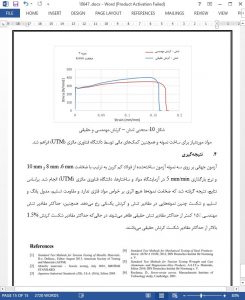Abstract
The most commonly accepted method in evaluation of the mechanical properties of metals would be the tension test. Its main objective would be to determine the properties relevant to the elastic design of machines and structures. Investigation of the engineering and true Stress-strain relationships of three specimens in conformance with ASTM E 8 – 04 is the aim of this paper. For the purpose of achieving this aim, evaluation of values such as ultimate tensile strength, yield strength, percentage of elongation and area reduction, fracture strain and Young's Modulus was done once the specimens were subjected to uniaxial tensile loading. The results indicate that the properties of steel materials are independent from their thickness and they generally yield and fail at the same stress and strain values. Also, it is concluded that the maximum true stress values are almost 15% higher than that of the maximum engineering stress values while the maximum true strain failure values are 1.5% smaller than the maximum engineering strain failure values.
1. Introduction
The significant role of the mechanical properties in evaluation of the fundamental properties of engineering materials along with development of new materials and also quality control of materials for application in design and construction cannot be neglected. Once a material is meant to be applied within an engineering structure that will be subject to loading, it must be guaranteed that the material possesses enough strength and rigidity to withstand the loads it will experience in its service life. Consequently, a number of experimental techniques have been developed by engineers for the purpose of mechanical testing of engineering materials subjected to tension, compression, bending or torsion loading. The tension test would be the most common type of test incorporated in measurement of the mechanical properties of materials. Provision of basic design information on materials strength is the purpose of conduction of tension test. Also, tension test is considered as an acceptance test for the specification of materials. Major parameters such as the tensile strength (UTS), yield strength or yield point (σy), elastic modulus (E), percent elongation (ΔL%) and the reduction in area (RA%) are obtained during the tension test in order to describe the stress-strain curve. Other parameters including toughness, resilience and Poisson’s ratio (ʋ) can also be calculated through the use of this testing technique. Conduction of the tensile test is done through application of longitudinal or axial load at a specific extension rate to a standard tensile specimen with known dimensions, including the gauge length and cross sectional area perpendicular to the load direction, until failure. In order to calculate the stress and strain, the applied tensile load and extension are recorded during the test.
4. Conclusions
The Universal Test was conducted on the three test specimens made of low carbon steel with a thickness of 6mm, 8mm and 10mm respectively and a loading rate of 5 mm/min at the Laboratory of Structures and Materials, Universiti Teknologi Malaysia (UTM). Based on the results, it was concluded that the thickness of the specimens had no effect on the properties of steel materials mainly yield strength and Young module and yielding and failure of such specimens occurs at the same stress and strain values. Also, the maximum engineering stress values appeared to be 15% lower than that of the maximum true stress values while the maximum engineering strain failure values are 1.5% higher than the maximum true strain failure values.











